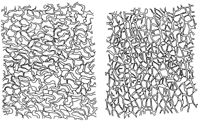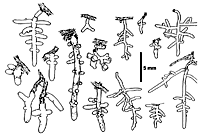Morphological features should only be examined by using fresh material, which has been, as far as possible, carefully cleaned from soil particles without loosing important features due to overdoing this operation. For this, the soil material has to be completely soaked in water. The finest tools have to be used: forceps, Pasteur pipettes, needles, and paint brushes.
Incident light of daylight quality is a prerequisite to view the colours. A black background facilitates examination and prevents a possible dazzling by a white background, and the ectomycorrhizae must be illuminated in an appropriate intensity. Mycorrhizae have to be kept in water to give them the possibility to stretch their emanating elements and to orient them in a most feasable natural manner. If further explanations are necessary see Agerer (1987ff): Colour Atlas of ectomycorrhizae and Agerer (1991): Methods in Microbiology 23: 25-73.
Although the plant genus is the most important component, some fungal relationships can control, at least partly, the final form. This has been shown for ectomycorrhizae on Fagus sylvatica with different fungi (A), and for Russula ochroleuca on different host genera (B).
 A |
 B |